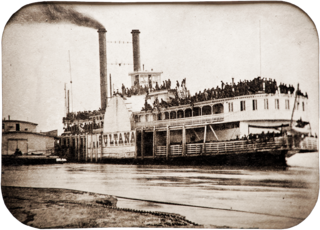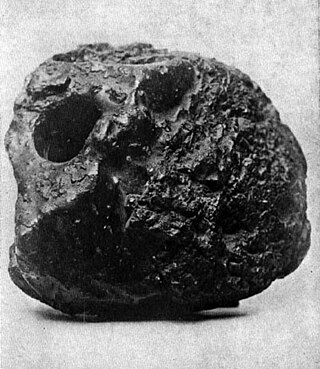Related Research Articles

A steamboat is a boat that is propelled primarily by steam power, typically driving propellers or paddlewheels. Steamboats sometimes use the prefix designation SS, S.S. or S/S or PS ; however, these designations are most often used for steamships.

Sultana was a commercial side-wheel steamboat which exploded and sank on the Mississippi River on April 27, 1865, killing 1,167 people in what remains the worst maritime disaster in United States history.

USS Tyler was originally a merchant ship named A. O. Tyler, a commercial side-wheel steamboat with twin stacks and covered paddles positioned aft. Constructed in Cincinnati, Ohio in 1857, it was acquired by the United States Navy, 5 June 1861 for service in the American Civil War and converted into the gunboat USS Tyler on 5 June 1861. She was commissioned in September 1861. She was protected with thick wooden bulwarks.

A boiler explosion is a catastrophic failure of a boiler. There are two types of boiler explosions. One type is a failure of the pressure parts of the steam and water sides. There can be many different causes, such as failure of the safety valve, corrosion of critical parts of the boiler, or low water level. Corrosion along the edges of lap joints was a common cause of early boiler explosions.

The coal torpedo was a hollow iron casting filled with explosives and covered in coal dust, deployed by the Confederate Secret Service during the American Civil War, and intended for doing harm to Union steam transportation. When it was shoveled into the firebox amongst the coal, the resulting explosion would at the very least damage the boiler and render the engines inoperable. At worst, a catastrophic boiler explosion would kill crewmen and passengers, start a fire, or even sink the vessel.

The Steamboat Inspection Service was a United States agency created in 1871 to safeguard lives and property at sea. It merged with the Bureau of Navigation in 1932 to form the Bureau of Navigation and Steamboat Inspection, which in 1936 was reorganized into the Bureau of Marine Inspection and Navigation. The Bureau of Marine Inspection and Navigation's responsibilities were transferred temporarily to the United States Coast Guard in 1942. The Bureau was abolished in 1946, when its functions were transferred permanently to the Coast Guard.
Robert Louden, also known by the alias Charlie Dale, was a Confederate saboteur and mail carrier during the American Civil War. He was said to be the primary messenger between General Sterling Price and Confederate regulars and bushwhackers.

Nutbush is a long-standing neighborhood in northeastern Memphis, Tennessee, United States.

Steamboats on the Columbia River system were wrecked for many reasons, including striking rocks or logs ("snags"), fire, boiler explosion, or puncture or crushing by ice. Sometimes boats could be salvaged, and sometimes not.
The steamboat Pennsylvania was a side wheeler steamboat which suffered a boiler explosion in the Mississippi River and sank at Ship Island near Memphis, Tennessee, on June 13, 1858.

Gazelle was an early sidewheeler on the Willamette River in what is now the U.S. state of Oregon. She did not operate long, suffering a catastrophic boiler explosion on April 8, 1854, less than a month after her trial voyage. This was the worst such explosion ever to occur in the Pacific Northwest states. The wrecked Gazelle was rebuilt and operated for a few years, first briefly as the unpowered barge Sarah Hoyt and then, with boilers installed, as the steamer Señorita. A victim of the explosion was D.P. Fuller, age 28, who is buried in Lone Fir Cemetery in Portland, Oregon.

The Lucy Walker steamboat disaster was an 1844 steamboat accident caused by the explosion of the boilers of the steamboat Lucy Walker near New Albany, Indiana, on the Ohio River. The explosion occurred on the afternoon of Wednesday, October 23, 1844, when the steamer's three boilers exploded, set the vessel on fire, and sank it. It was one of a number of similar accidents of early 19th-century riverine transportation that led to important federal legislation and safety regulations. The vessel's owner was a Native American; her crew were African-American slaves, and her passengers represented a cross-section of frontier travelers.
Events from the year 1865 in the United States. The American Civil War ends with the surrender of the Confederate States, beginning the Reconstruction era of U.S. history.

CSS Tuscaloosa was an ironclad warship that served in the Confederate States Navy during the American Civil War. Construction began in May 1862, under a contract with Henry D. Bassett. Her engines were taken from the steamboat Chewala, and she was armored with 4 inches (10 cm) of iron and armed with four cannons. In January 1863, she was launched, and traveled down to Mobile, Alabama for service on Mobile Bay. Both Tuscaloosa and her sister ship CSS Huntsville were found to be too slow for practical use, and were relegated to service as floating batteries. Union forces captured Mobile in April 1865, and Tuscaloosa was scuttled on April 12, as she was unable to escape due to an inability to steam against the current on the Spanish River. Her wreck was discovered in the 1980s.
The California Steam Navigation Company was formed in 1854 to consolidate competing steamship companies in the San Francisco Bay Area and on the Sacramento and San Joaquin Rivers. It was successful in this effort and established a profitable near-monopoly which it maintained by buying out or bankrupting new competitors. In response to the Fraser Canyon gold rush and economic growth in the Pacific Northwest, the company expanded to ocean routes from San Francisco north to British Columbia. Similarly, as California's economy grew, the company offered service from San Francisco south to San Pedro and San Diego. It exited these markets in 1867 when competition drove prices to unprofitable levels. While the California Steam Navigation Company was successful throughout its life in suppressing steamboat competition on its core Bay Area and river routes, it could not control the rise of railroads. These new competitors reduced the company's revenue and profit. Finally, in 1871, the company's assets were purchased by the California Pacific Railroad, and the corporation was dissolved.
William R. Harris was a justice of the Tennessee Supreme Court from 1855 to 1858.

The Upper Willamette Transportation Line was a line of four inland steamboats that operated from the fall of 1859 to the summer of 1860 on the upper Willamette River in the state of Oregon, United States.

The Huntsville-class ironclads consisted of two casemate ironclads ordered by the Confederate States Navy in 1862 to defend Mobile, Alabama, during the American Civil War. Completed the following year, they used propulsion machinery taken from steamboats, and were intended to be armored with 4 inches (102 mm) of wrought iron and armed with four cannons. Both CSS Tuscaloosa and her sister ship CSS Huntsville were found to be too slow for practical use, and were relegated to service as floating batteries. Union forces captured Mobile in April 1865, and the sisters were scuttled on April 12, as they were unable to escape due to an inability to steam against the current on the Spanish River.
The SS Helen McGregor was an American steamboat. Her boilers exploded on February 24, 1830, in Memphis, Tennessee. The reported death toll ranged from 30 or 40 to 60. She had been docked at a wharf to pick up and discharge passengers; several of those killed were on the dock. More the 270 people had died various in steamship boiler explosions beginning in 1825; after the Helen McGregor the United States Congress asked "the secretary of the Treasury to investigate the boiler accidents."
References
- ↑ Ullrich, Dieter (2020). "The Explosion of the Steamer Eclipse". West Tennessee Historical Society Papers. Faculty Research at Morehead State University. 74: 54–72.
- ↑ Tennessee in the Civil War: Selected Contemporary Accounts of Military and Other Events, Month by Month. McFarland. 2014-01-10. p. 254. ISBN 978-0-7864-8567-3.
- ↑ "THE WAR IN THE SOUTHWEST.; Steamboat Explosion and Loss of Life Capture of a Band of River Depredators. Railroad Accident". The New York Times. 1865-01-30. ISSN 0362-4331 . Retrieved 2023-06-28.